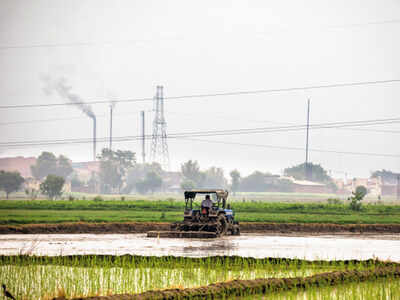
HISAR: If the drastic changes in the weather continues, in about 15 years, the yield of wheat will be reduced by 8% and rice by 11% and by 2095, the yield of wheat will fall by 57% and rice by 34%. A study by environmental science & engineering department of Guru Jambheshwar University of Science and Technology had concluded this.
Titled ‘climate change: does it really matter for Haryana?’ the study was conducted by Sohan Lal, a research scholar of the department under the supervision of professor Narsi Ram Bishnoi, dean of research, Guru Jambheshwar University of Science and Technology.
According to agriculture statistics of 2017, Haryana is fourth in wheat cultivation and 10th in rice production in the country.
For the study, Haryana was divided into three climate zones — dry sub-humid, semi arid region and arid zone. The Marskim DSSAT weather generator meteorological data tool was used for forecasting temperature and rainfall from 2010 to 2095.
According to the study, in Ambala district, which falls under dry sub-humid, baseline temperature was 25.58 °C (degree celsius) with baseline rainfall 827.3mm in 2015 and it shows temperature increase from 0.49-0.91°C by 2035, 0.80-2.94°C by 2065 and 0.80-5.25 °C by 2095. Similarly, the rainfall is found increasing up to 21.6-50mm by 2035, 28.9-63.9mm by 2065, and 36.5-90.30mm by 2095.
In Karnal district, which comes under semi arid, baseline temperature observed was 25.41°C with baseline rainfall 675.6mm in 2015 and it shows temperature increase from 0.52-0.91 °C by 2035, 0.85-2.91 °C by 2065 and 0.84-5.22 °C by 2095. Similarly, the rainfall is found increasing up to 14.7-51.7mm by 2035, 33.9-71.5mm by 2065, and 36.1-94.70 mm by 2095.
In Hisar district, which is taken as an example of arid region, the baseline temperature was 26.19°C with baseline rainfall 418.2mm in 2015 and it shows temperature increase from 0.49-0.85°C by 2035, 0.86-2.92°C by 2065 and 0.87-5.34°C by 2095. Similarly, the rainfall is found increasing up to 3.3-31mm by 2035, 3.7-28mm by 2065 and 1.4-55.9mm by 2095.
The rise in temperature will cause reduction in wheat yield — up to 8% with 1°C rise, up to 22% with 2°C rise, up to 38% with 3°C rise, and up to 57% with 5°C. Similarly, the reduction in rice yield has been studied up to 11%, 23%, 30%, and 34% with the rise in temperature around 1°C, 2°C, 3°C, and 5°C, respectively.
Titled ‘climate change: does it really matter for Haryana?’ the study was conducted by Sohan Lal, a research scholar of the department under the supervision of professor Narsi Ram Bishnoi, dean of research, Guru Jambheshwar University of Science and Technology.
According to agriculture statistics of 2017, Haryana is fourth in wheat cultivation and 10th in rice production in the country.
For the study, Haryana was divided into three climate zones — dry sub-humid, semi arid region and arid zone. The Marskim DSSAT weather generator meteorological data tool was used for forecasting temperature and rainfall from 2010 to 2095.
According to the study, in Ambala district, which falls under dry sub-humid, baseline temperature was 25.58 °C (degree celsius) with baseline rainfall 827.3mm in 2015 and it shows temperature increase from 0.49-0.91°C by 2035, 0.80-2.94°C by 2065 and 0.80-5.25 °C by 2095. Similarly, the rainfall is found increasing up to 21.6-50mm by 2035, 28.9-63.9mm by 2065, and 36.5-90.30mm by 2095.
In Karnal district, which comes under semi arid, baseline temperature observed was 25.41°C with baseline rainfall 675.6mm in 2015 and it shows temperature increase from 0.52-0.91 °C by 2035, 0.85-2.91 °C by 2065 and 0.84-5.22 °C by 2095. Similarly, the rainfall is found increasing up to 14.7-51.7mm by 2035, 33.9-71.5mm by 2065, and 36.1-94.70 mm by 2095.
In Hisar district, which is taken as an example of arid region, the baseline temperature was 26.19°C with baseline rainfall 418.2mm in 2015 and it shows temperature increase from 0.49-0.85°C by 2035, 0.86-2.92°C by 2065 and 0.87-5.34°C by 2095. Similarly, the rainfall is found increasing up to 3.3-31mm by 2035, 3.7-28mm by 2065 and 1.4-55.9mm by 2095.
The rise in temperature will cause reduction in wheat yield — up to 8% with 1°C rise, up to 22% with 2°C rise, up to 38% with 3°C rise, and up to 57% with 5°C. Similarly, the reduction in rice yield has been studied up to 11%, 23%, 30%, and 34% with the rise in temperature around 1°C, 2°C, 3°C, and 5°C, respectively.

Coronavirus outbreak
Trending Topics
LATEST VIDEOS
More from TOI
Navbharat Times
Featured Today in Travel
Quick Links
Kerala Coronavirus Helpline NumberHaryana Coronavirus Helpline NumberUP Coronavirus Helpline NumberBareilly NewsBhopal NewsCoronavirus in DelhiCoronavirus in HyderabadCoronavirus in IndiaCoronavirus symptomsCoronavirusRajasthan Coronavirus Helpline NumberAditya ThackerayShiv SenaFire in MumbaiAP Coronavirus Helpline NumberArvind KejriwalJammu Kashmir Coronavirus Helpline NumberSrinagar encounter
Get the app







